Finding your Roots in West Africa, October 13-22, 2021 Group Trip
Not escorted by Cindi LaRaia
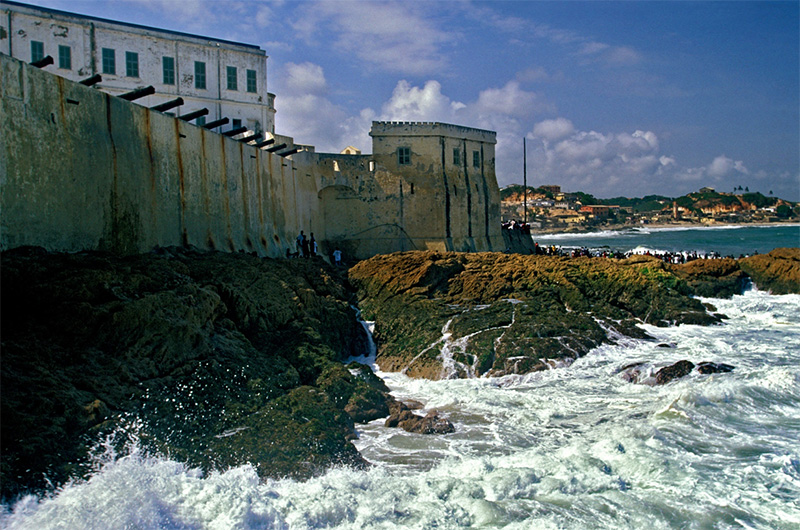
Ghana, Togo, Benin:
Discover Your Roots in a Lively Africa
10 Days / 9 Nights
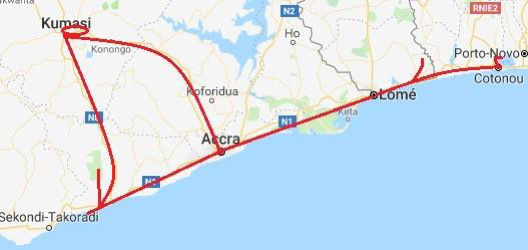
ITINERARY
Day 1:
Cotonou - Benin
Arrival in Cotonou and transfer to the hotel.
Meals: own arrangements
Overnight: Hotel du Lac (all rooms ensuite and with aircon)
Day 2:
The Gate of non-Retour: Cotonou - Ouidah Benin (2H drive)
We cross Lake Nokwe with a motorized boat to reach Ganvié, the largest and most beautiful African village on stilts. The approximately 25,000 inhabitants of the Tofinou ethnic group build their wooden huts on teak stilts. Fishing is their main activity. Ganvié has managed to preserve its traditions and environment despite the long-lasting human presence in a closed setting; and the lake is not over-fished. Daily life unfolds in the dugout canoes that adults and children row with ease using brightly coloured paddles. From these canoes, men fishing, women expose goods at the “floating market”, children go to school and play.
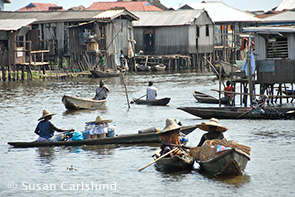
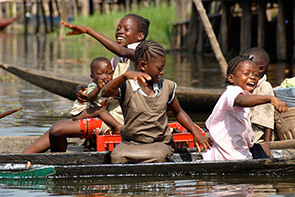
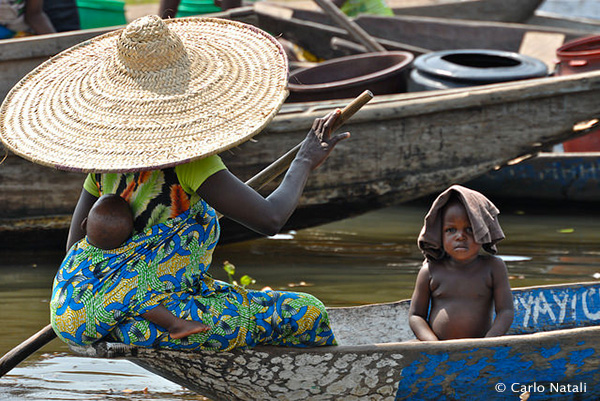
In the afternoon arrive in Ouidah. Ouidah was conquered by the Dahomey army in the XVIII cent and transformed into a terminal for the slaves’ trade. Today, the city is characterized by Afro-Portuguese architecture and the python temple is built face to face the Catholic Cathedral. The laid-back attitude of the locals mixes with the thunder of the distant waves on the beach and the rhythm of the drums creates an atmosphere outside of time, very well described by Bruce Chatwin in his book, "The Vice-Roi of Ouidah".
Walking down the streets we visit the python temple and the Portuguese fort, now transformed into a museum where the history of Ouidah and the transatlantic salve trade are displayed. We finish our tour by following the “slave route” to the “Gate of non-retour” by the beach where the slaves were shipped to the “new world”.
Meals: B-L-D
Overnight: Hotel Jardin Brezilien (all rooms ensuite and with aircon)
Day 3:
At the heart of Voodoo: Ouidah - Lomé Benin & Togo (2H drive)
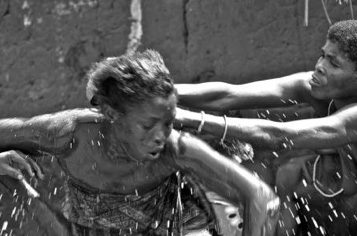 Togo border crossing (Hilla Kodji / Save Kodji).
Togo border crossing (Hilla Kodji / Save Kodji).
Voodoo has a long history. It developed in Togo and Benin and it was brought to America by the African slaves coming from the Gulf of Guinea. As time passed, Voodoo adapted to the new environment creating different rituals and beliefs. Nowadays, in cities like New Orleans people still practice Voodoo. Therefore, it is interesting to visit the land where Voodoo first developed and where so many people still believe and practice it.
In a remote hidden village, we will join a Voodoo ceremony: the frenetic rhythm of the drums and the chants of the adepts’ help calling in the voodoo spirit who then takes possession of some of the dancers. They fall into a deep trance: eyes rolling back, grimaces, convulsions, insensitivity to fire or pain. Sakpata, Heviesso, Mami Water are just some of the voodoos divinities who can show up. In this narrow village, surrounded by the magic atmosphere of the ceremony, we will finally understand what people mean when they say: “In your Churches you pray God; in our voodoo shrine we become God!”
Then we will meet a traditional healer who treats his patients with voodoo rites and herbs. The treatments are effective for almost all diseases, especially for insanity. His shrine is impressive. The endless list of voodoos shows the endless powers concentrated in the site.
Drive and overnight in Lomé.
Meals: B - L - D
Overnight: Hotel Napoleon Lagune (all rooms ensuite with aircon)
Day 4:
Fetish Market and Textiles: Lomé - Accra Togo & Ghana (4H Drive)
Lomé, the vibrant capital of Togo, is the only African city which was a colony of the Germans, the British and the French. It is also one of the few capitals in the world bordering with another nation. These elements have led to the development of a unique identity reflected in the life style of its inhabitants and in the architecture of the town: Lomé is indeed a cross point for people, trade and cultures, a cosmopolitan city in small size. We will visit: the central market with its famous “Nana Benz”, women who control the market of the expensive “pagne” (=cloths) coming from Europe and sold all over West Africa; the colonial buildings in the administrative quarter where the flavour of colonial time is still very present. In order to complete our understanding of Voodoo, we will make a stop at the fetish market where we will be explained the curative power of voodoo and where we can find an eclectic assortment of all the necessary ingredients for love potions and magical concoctions.
Ghana border crossing (Aflao).
Drive and overnight in Accra.
Meals: B - L - D
Overnight: Hotel Villa Boutique (all rooms ensuite with aircon)
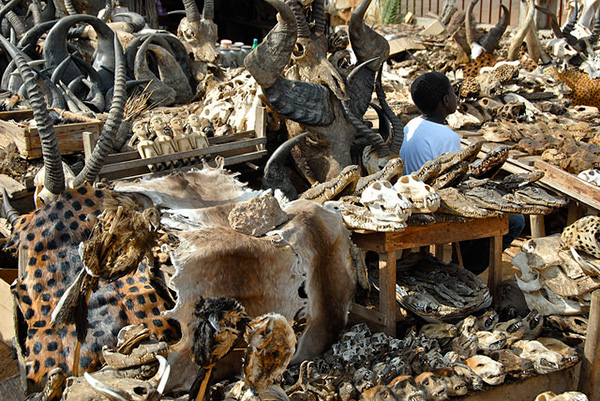
Day 5:
Metropolis of Africa: Accra Ghana
Waking up in Accra can be quite a shock after having spent the previous day in Lomé. The former is indeed a metropolis going through a fast development. Skyscrapers and modern buildings shape the financial quarter where ladies and gentlemen walk down the streets in nice suites. This quarter vanishes into the first settlement of Accra: the quarter of James Town, inhabited by the local population known as the Ga. Our visit includes the visit of James Town, among other things we will visit the former slave prisons of Ussher Fort and James Fort. Two of the many European forts built along the Ghanaian coast, these military posts were used to store commodities and to hold West African slaves before they were shipped overseas. At Ussher Fort, head inside the museum that charts Ghana’s slave trade with poignant artefacts and displays.
If possible, we will see the National Museum (now under renovation), one of the first works of independent Ghana - the idea inspiring the Museum is to relate Ghanaian art to the rest of the continent and to prove the existence of an African history as part of the general history of humanity.
Our tour ends with the visit of a workshop where they specialize in building fantasy coffins. These special handcrafted coffins can reflect any shape: fruits, animals, fish, cars, airplanes…. the only limit being imagination! Started in Africa, these flamboyant coffin designs are by now collected worldwide and exposed in museums.
Meals: B - L - D
Overnight: Hotel villa boutique (all rooms ensuite with aircon)
Day 6:
Ashanti Memorials: Accra - Kumasi Ghana (5H Driving)
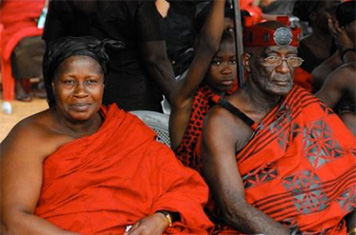 Today is a transfer day. We will reach Kumasi, the capital of the Ashanti kingdom.
In the afternoon we attend- if available- a traditional Ashanti funeral attended by mourners wearing beautifully red or black togas. We say “funerals” but in fact we mean a “festive” celebration: the deceased is considered being still present in his family. The relatives and friends gather, socialize and celebrate his memory. The chief arrives surrounded by his court in the shade of large umbrellas as drums give rhythm to the dancers whose intricate moves are highly symbolic.
Today is a transfer day. We will reach Kumasi, the capital of the Ashanti kingdom.
In the afternoon we attend- if available- a traditional Ashanti funeral attended by mourners wearing beautifully red or black togas. We say “funerals” but in fact we mean a “festive” celebration: the deceased is considered being still present in his family. The relatives and friends gather, socialize and celebrate his memory. The chief arrives surrounded by his court in the shade of large umbrellas as drums give rhythm to the dancers whose intricate moves are highly symbolic.
Meals: B - L - D
Overnight: Miklin Hotel (all rooms ensuite with aircon)
Day 7:
Akwasidae Ghana
Kumasi is the historical and spiritual capital of the old Ashanti Kingdom. The Ashanti people were one of the most powerful nations in Africa until the end of the 19th century, when the British annexed the Ashanti country to their Gold Coast colony.
In the Royal Palace of Kumasi (Ghana) we attend the Akwasidae Festival.
The Ashanti have their own traditional calendar in which every first day of the month is celebrated as the Akwasidae Festival. After libations are poured over the thrones of the former kings in some private rooms comes the time of the great happy ceremony. In the shade of a highly colourful umbrella sits the king, wrapped in brightly coloured fabric and adorned with antique solid gold jewellery (Ashanti golden jewels and masks are considered master pieces of African art). At the feet of her majesty opens up a narrow corridor made of dignitaries with various functions: ritual sword bearers, guards armed with powder rifles, courtiers carrying the knives used for executions, and carriers of ostrich feather fans. Next to the king are seated the elders and the advisers under the authority of the royal speaker who holds in his hands the symbols of power covered in gold. During the ceremony, the courtiers bring their gifts and the “griots” tell the story of the past Ashanti kings, while drum and ivory trump players give rhythm to the ceremony. Pretty big women, wrapped in a vivid red cloth, perform traditional dances characterized by a series of delicate movements alternated with rapid moves from one end of the stage to the other.
This authentic ceremony takes place in one of the last African kingdom to have kept unchanged all of its rituals. We will experience the splendour, the colours and the atmosphere of the great monarchies of the forest of yesteryear.
On the agenda is a visit to the Ashanti Cultural Centre, which has a rich collection of Ashanti artefacts housed in a wonderful reproduction of an Ashanti house.
Today with nearly one million inhabitants, Kumasi is a sprawling city with a fantastic central market, one of the biggest in Africa. Every kind of Ashanti craft (leather goods, pottery, Kente cloth) is found here, along with just about every kind of tropical fruit and vegetable. We will end the tour by visiting the central market.
Meals: B - L - D
Overnight: Miklin Hotel (all rooms ensuite with aircon)
Day 8:
Slaves’ Coast: Elmina Ghana (4H Drive)
We will leave Kumasi to reach Elmina. Here we will visit Elmina Fort, the oldest European building in Africa, erected by the Portuguese in the 15th century. At different times the castle has been used as a warehouse to trade gold, ivory, and eventually slaves. The castle we visit today is the result of successive extension works and is recognized as a UNESCO World Heritage site. The old Dutch Cemetery in Elmina goes back to 1806. Outside the castle, a spectacular fishing village with lots of large colourful fishing boats - every day these wooden large pirogues conducted by skilled fishermen across strong ocean waves and currents, “fighting” to earn a living. In the old town we will see the Posuban, the shrines of the ancient “Asafo companies” - the warriors who used to put their offerings on the large colourful statues. The alleys in the old town have a very lively atmosphere, bringing us back to a time when Elmina was a busy colonial town.
Meals: B - L - D
Overnight: Anomabu Beach Resort, Ocean front resort with comfortable bungalows on the beach (all bungalows ensuite and with aircon)
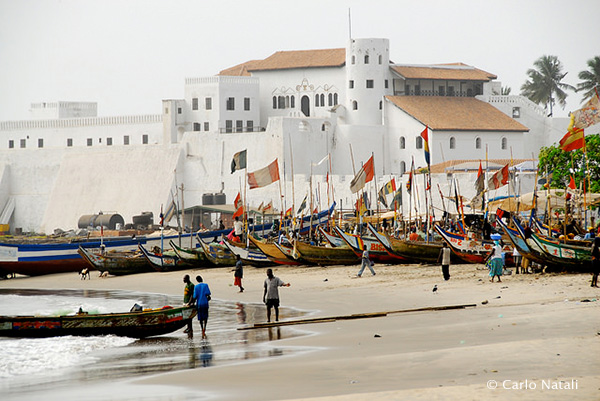
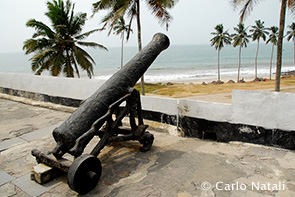
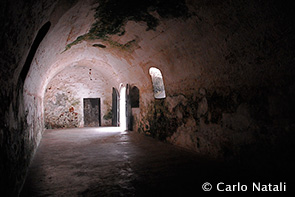
Day 9:
History and Nature: Cape Coast and Kakum Park Ghana
We end our journey on the history of transatlantic slavery with an excursion to Cape Coast. Cape Coast is one of about forty UNESCO heritage “slaves castles” built on the Gold Coast of West Africa (now Ghana) by European traders. It was originally built by the Swedes for trade in timber and gold, but later used in the trans-Altlantic slave trade. The castles were used to hold salves before they were loaded onto ships and sold in the Americans, especially the Carribean. This “gate of no return” was the last stop vefore crossing the Altlantic Ocean.
In the afternoon we will visit Kakum National Park, a few kilometres north of the coast, in the middle of the rainforest. This park gives us a great opportunity to observe the forest from above as Kakum has a canopy walk hang high up in trees. The Kakum canopy walkway is the longest and highest rope bridge in the world. Walking between 120 and 150 feet above the ground, we will enjoy an incredible view of the rain forest. At this height instead of revealing their trunks, the trees offer a breath-taking view of their canopies and look as if they were trying to touch the sun and the sky above.
Meals: B - L - D
Overnight: Anomabu Beach Resort, Ocean front resort with comfortable bungalows on the beach (all bungalows ensuite and with aircon)
Day 10:
Cape Coast - Accra Out Ghana (4H Driving)
We can enjoy some relax on the beach before leaving the coast to head back to Accra.
Rooms in day-use for the last shower and transfer to the airport.
Meals: B - L
Overnight: Rooms in day-use at hotel villa boutique (all rooms ensuite with aircon)
*** End of the services ***
COST: 2,085 Euro per person in sharing double
Single supplement: 432 Euro
Included
- Assistance at airport upon arrival (day 1) and departure (day 10)
- Transfers and tour in minibuses/microbuses and/or 4WD vehicles
- Local guide (languages spoken: English, French, German, Italian and Spanish)
- Tours and visits as per the programme
- Accommodation in standard rooms, as per itinerary
- All meals as described: B = breakfast, L = lunch, D = dinner
- Mineral water in the bus/car during the visits
- Entrance fees to parks, concessions, protected areas and cultural sites
- First Aid box
- All service charges and taxes
Not included
- International flights
- Earlier (prior day 1) and/or later (after day 10) transfers from and to airport
- Visa fees and any airport departure taxes
- Any meal or sightseeing tour other than those specified
- Mineral water and drinks at meals
- Porterage
- Fees for personal photos and videos
- Personal and holiday insurance (compulsory)
- Tips for drivers, guides and hotel staff
- Costs relating to delayed or lost luggage
- Any item of personal nature such as phone calls, laundry, etc.
- Whatever is not mentioned as included
For more information
Contact:
Africa Discovery
@
1 800 886-7321
(415) 444-5100
or
Request Info




